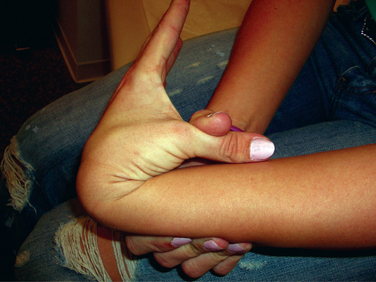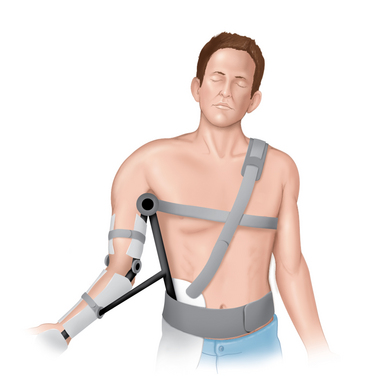CHAPTER 9 Nonoperative treatment of anterior shoulder instability
 Rehabilitation for nonoperative treatment of shoulder instability should focus on early glenohumeral motion, strengthening of the subscapularis, scapular control, and glenohumeral proprioceptive training.
Rehabilitation for nonoperative treatment of shoulder instability should focus on early glenohumeral motion, strengthening of the subscapularis, scapular control, and glenohumeral proprioceptive training. In the majority of cases, nonoperative treatment of acute anterior shoulder instability is effective in permitting in-season athletes to complete their season.
In the majority of cases, nonoperative treatment of acute anterior shoulder instability is effective in permitting in-season athletes to complete their season. Nonoperative treatment of acute anterior shoulder instability is not appropriate for athletes engaged in activities during which a recurrent dislocation could produce catastrophic injury (e.g., rock climbing, skydiving, motocross, rodeo), or those in whom significant structural injury has occurred (e.g., rotator cuff tear; displaced greater tuberosity fracture; massive Hill-Sachs lesions; or large, anterior-inferior glenoid rim fracture).
Nonoperative treatment of acute anterior shoulder instability is not appropriate for athletes engaged in activities during which a recurrent dislocation could produce catastrophic injury (e.g., rock climbing, skydiving, motocross, rodeo), or those in whom significant structural injury has occurred (e.g., rotator cuff tear; displaced greater tuberosity fracture; massive Hill-Sachs lesions; or large, anterior-inferior glenoid rim fracture).Introduction
A variety of factors must be considered when contemplating operative versus nonoperative treatment of anterior glenohumeral instability, including etiology (e.g., traumatic versus atraumatic/generalized ligamentous laxity), age, number of instability events, activity level, and presence of concomitant pathology (e.g., rotator cuff tear, significant bony injury to the glenoid and humeral head). An increasing amount of data supports excellent results with early operative stabilization following a first-time, traumatic anterior dislocation event in the young, active individual, particularly those involved in military exercises, collision sports, or similar types of extreme activities (rock climbing, motocross, rodeo, etc.).1–3 However, strong consideration should be given to initial nonoperative treatment in many cases of anterior shoulder instability, including those with no clear traumatic etiology, selected in season athletes, older low-demand patients, and patients choosing to adopt appropriate activity modifications. Not all patients will go on to develop recurrent instability following a first-time, traumatic anterior dislocation, and among those who do, timing of operative intervention may not dictate prognosis.4,5 Nonoperative treatment can, in many cases, result in early return to recreational or competitive sports and may be particularly appropriate for allowing selected in-season athletes to complete their season.5,6
Physical examination
If the patient presents within 7 to 10 days of the dislocation event, particularly if the injury represents an index dislocation, little beyond limited neuromuscular evaluation should be performed. Axillary nerve and distal neuromuscular function should be assessed. At the time of later evaluations (between 2 to 6 weeks), as the patient’s active range of motion returns, focus should shift to evaluation of the rotator cuff, especially the subscapularis. Although not typical, one should note that a patient may regain normal or near-normal active forward elevation even in the setting of a ruptured subscapularis. If function of this muscle is not targeted specifically with lift-off, belly-press, and bear-hug testing, then injury to it may be missed and the opportunity for anatomic repair before the onset of retraction and atrophy along with it.
Accessory plain film views
Treatment
Nonoperative treatment of anterior shoulder instability has raised questions regarding use, length, and type of immobilization of the affected shoulder. Although simple sling immobilization for 3 to 4 weeks following initial injury has not been shown to influence risk of recurrence, there is increasing evidence to suggest that immobilization in abduction and external rotation results in more anatomic coaptation of a traumatically torn capsulolabral unit, thereby improving the ultimate stability of the nonoperatively treated shoulder following first-time anterior glenohumeral dislocation.5,10–14 Placing the glenohumeral joint in a position of abduction and external rotation reduces the anterior-inferior labrum and associated anterior band of the inferior glenohumeral ligament to the glenoid in a more anatomic fashion than the internally rotated, “at the side” position adopted with use of a simple sling (Figs. 9-2 and 9-3). The obvious clinical correlation drawn from this observation is that use of abduction-external rotation postinjury immobilization may promote more effective healing of the injured capsulolabral complex and thereby reduce risk of recurrent instability. Use of external rotation bracing may be particularly effective when implemented within 3 days of injury, if the patient is younger than 30 years of age and if the dislocation is a first-time, traumatic anterior dislocation.12 Nevertheless, despite impressive initial evidence, longer-term follow-up is needed before firm recommendations can be made regarding use of external rotation bracing following first-time anterior glenohumeral dislocation. The authors currently do not use immobilization of any type beyond a simple sling and do not recommend a length of immobilization beyond any period necessary for the discomfort of the initial event to resolve (typically 1 to 4 days).
Stay updated, free articles. Join our Telegram channel

Full access? Get Clinical Tree










